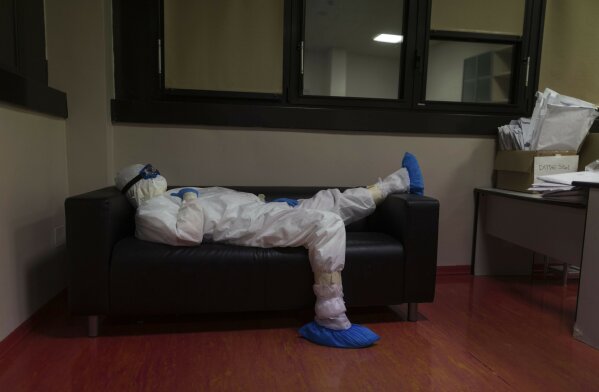What you need to know today about the virus outbreak
What you need to know today about the virus outbreak
Places with declining coronavirus infections and strong testing would be able to begin a three-phased gradual reopening of businesses and schools under new White House guidelines.
The approach was outlined by President Donald Trump on a call with the nation’s governors as the extent and depth of the financial pain from the global pandemic became clearer with the ranks of America’s unemployed swelling toward Great Depression-era levels.
But it doesn’t look as if life will be returning to normal anytime soon. Some places could see at least some restrictions remain in place through the end of the year.
Here are some of AP’s top stories Thursday on the world’s coronavirus pandemic. Follow APNews.com/VirusOutbreak for updates through the day and APNews.com/UnderstandingtheOutbreak for stories explaining some of its complexities.
WHAT’S HAPPENING TODAY:
—The record-setting flood of layoffs unleashed by the virus outbreak is extending beyond the service industries to white collar employees, ranging from software programmers and legal assistants to sales associates and some health care workers.
—An extraordinary number of deaths overwhelmed a nursing home in New Jersey where police found 18 bodies in a “makeshift morgue.”
—A Spanish funeral director does what he can to show respect for the dead while working in an underground parking garage-turned-morgue currently housing the bodies of over 500 victims of the pandemic.
—Some Roman Catholics may be returning to church after a diocese in New Mexico announced it will allow a small number of people to attend public celebrations of Mass in what could be the first move to alter a diocese-declared ban on public services in the U.S.
WHAT YOU NEED TO KNOW:
For most people, the coronavirus causes mild or moderate symptoms, such as fever and cough that clear up in two to three weeks. For some, especially older adults and people with existing health problems, it can cause more severe illness, including pneumonia and death. The vast majority of people recover.
Here are the symptoms of the virus compared with the common flu.
One of the best ways to prevent spread of the virus is washing your hands with soap and water. The U.S. Centers for Disease Control and Prevention recommends first washing with warm or cold water and then lathering soap for 20 seconds to get it on the backs of hands, between fingers and under fingernails before rinsing off.
You should wash your phone, too. Here’s how.
TRACKING THE VIRUS: Drill down and zoom in at the individual county level, and you can access numbers that will show you the situation where you are, and where loved ones or people you’re worried about live.
___
ONE NUMBER:
— 22 million: Roughly 22 million have sought jobless benefits in the past month — easily the worst stretch of U.S. job losses on record.
___
— LOVERS’ GAZE: A co-worker snapped a photo of two nurses, a husband and wife, in an eye-to-eye embrace despite layers of protective gear. The image is inspiring people around the globe.
— HELPING CONNECTIONS: A 19-year-old Rhode Island man has set up a program to help coronavirus patients who aren’t allowed to receive visitors while in the hospital stay connected to their loved ones.
___
Follow AP coverage of the virus outbreak at https://apnews.com/VirusOutbreak and https://apnews.com/UnderstandingtheOutbreak








